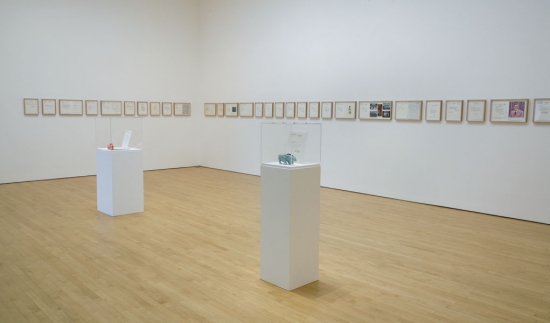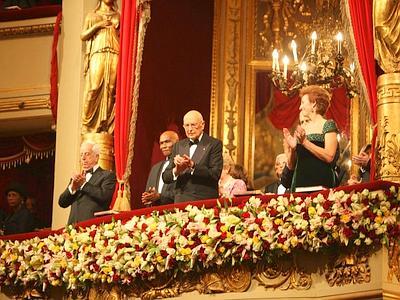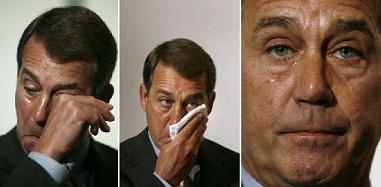I woke up Wednesday morning to news of fracas at the opera. The La Scala opera house in Milan had just hosted its annual gala, the sort of event heads of state and millionaires attend (box seats went for 2,000 euros each). The gala happens every year, and every year, protesters line up outside to dispute one thing or another; it’s too good to pass up when the president and the country’s top execs and stars are all sharing a night out. This year, budget cuts fueled much of the dissent. And this year, there were “clashes” between students and geared-up police officers, tear gas, firecrackers, smoke bombs, arrests, and hospital trips.
As the gassing and clashing occurred outside, Daniel Barenboim, the same Jewish virtuoso known for bringing Wagner to Israel and receiving honorary Palestinian citizenship, was inside, preparing to conduct The Valkyrie. But before lifting the baton, he reportedly turned to the audience and looked directly into President Giorgio Napolitano’s box. “We are deeply worried for the future of culture in the country and in Europe,” he said as applause erupted. Of course, Napolitano clapped, too. In the single photograph I have seen from that evening, he looks like he’s even smiling, which isn’t something he’s known for. And he should have been; even if he’s not about to reevaluate budget cuts, enjoying art was his job Tuesday night.
Politicians and art have been on my mind lately. I assume I’m not alone, following the events of last week, involving two Republican soon-to-be House leaders who went up in arms about the Hide/Seek exhibition at the National Portrait Gallery, leading to the removal of an exquisite and important video by activist-artist David Wojnarowicz. (Guest contributor Dorota Biczel wrote this spot-on response to the debacle).
The truth is, the senators who fueled the ruckus, Eric Kantor, a Republican “Young Gun,” and speaker in-waiting John Boehner, a veteran with a golfing habit and a strikingly natural tan, are among the least surprising participants in the whole affair. The world works the way you’d expect it to when two conservative politicians, eager to appeal to the social right, decide to make a stink about supposedly offensive art with which neither has spent time.
But what does it mean that politicians again and again seem to grossly misunderstand art — its motivation and function? Los Angeles artist Jeffrey Vallance explored this question years ago, in a 1978 project called Drawings and Statements by US Senators. The project currently hangs in a back hallway at Margo Leavin Gallery in West Hollywood, and, though I’d seen it before, I had an urge to visit it again earlier this week.
Vallance made this particular work while a college student. He sent handwritten notes to each state senator, asking if they would contribute a drawing and some thoughts to his project on art and government. Nearly a third responded, and the small framed letters, most on official letterhead are truly exquisite — though at times incensing — artifacts. The tone of their letter suggest the senators unamimously assumed Vallance was a child working on an elementary or middle school report — who else would be silly enough to ask them to draw?
With few exceptions, the politicians’ understanding of art seems tied to regionalism and patriotism. Jesse Helms took the opportunity to say that he has chosen two paintings by a North Carolina artist to hang in his office, clearly proof of his art savvy. Orrin Hatch pointed out that Utah has an exceptional cadre of representational painters who are often passed over for the less talented conceptual or abstract artists who seem to all the rage these days. Dick Stone sent a signed picture of himself. William Proximire sent a swirling abstraction in blue and green pen (“you’ll have to use your imagination to tell what it is,” he told Vallance). Many pointed out that they had no talent and sent drawings by “more talented” staff members, of U.S. flags or capital buildings. Adlai Stevenson assured Vallance that the arts were extremely important to him even though he “dare not hazard a drawing.”

Jeffrey Vallance, installation view, "BELIEF SYSTEM: 1970s Political Work and Reliquary Chapels," 2007. Courtesy Margo Leavin Gallery.
My favorite contribution, the one that seems to get it, comes from Barry Goldwater. He sent Vallance an idiosyncratic rendering of a cactus with a burly trunk and poetically extended limbs, something common in his home state that he said he cares about deeply. You can see eraser marks on the paper, and his accompanying letter explains what the drawing depicts, in case Vallance can’t tell. It shows an endearing vulnerability, a genuine effort, and the investment of time, which seems to be what many of his peers and, more recently, Boehner and Kantor, either overlook or simply disregard: art takes time, and taking the time to immerse yourself in the experience of making and looking is usually the whole point. To make a judgment without spending that time is always to be rashly ill-informed.





